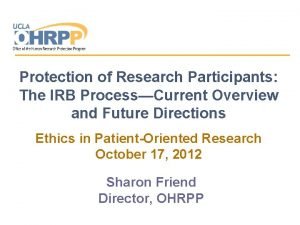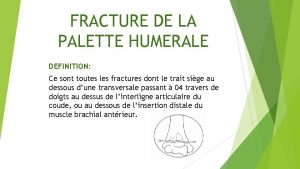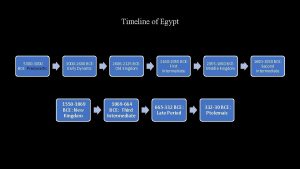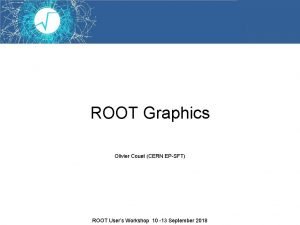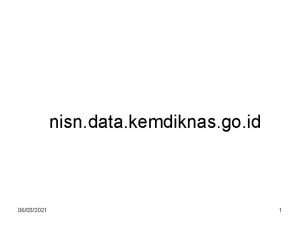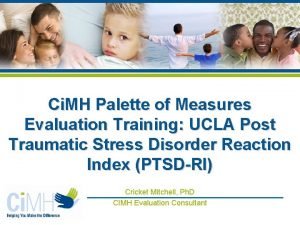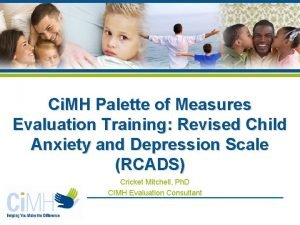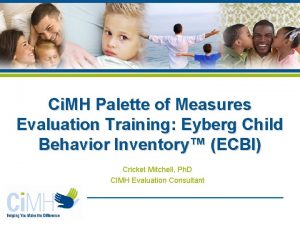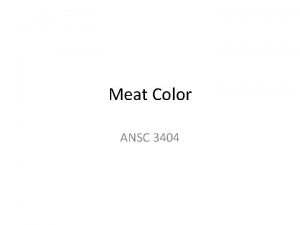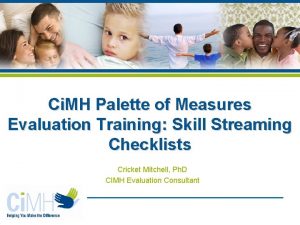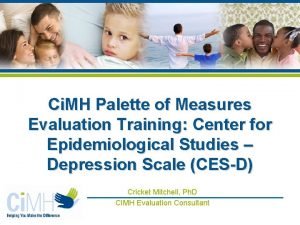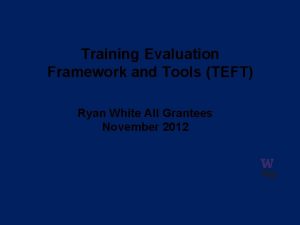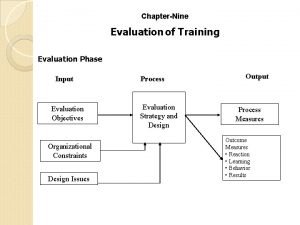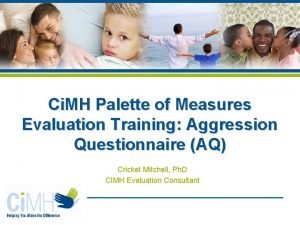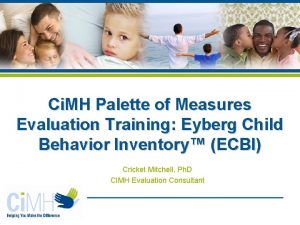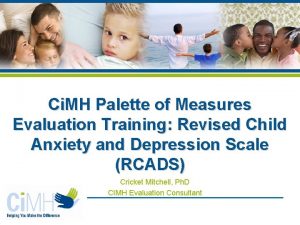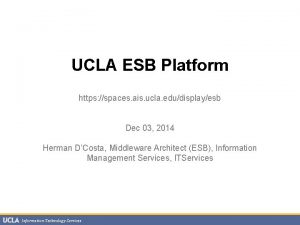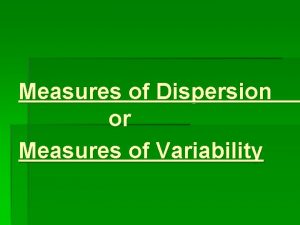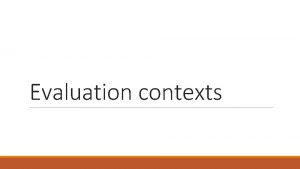Ci MH Palette of Measures Evaluation Training UCLA












































- Slides: 44

Ci. MH Palette of Measures Evaluation Training: UCLA Post Traumatic Stress Disorder Reaction Index (PTSD-RI) Cricket Mitchell, Ph. D CIMH Evaluation Consultant

Palette of Measures Evaluation: What You Will Need (slide 1 of 2) • Palette of Measures Data Entry Shell v 2 (Excel file) – Developed by Ci. MH and customized for each participating agency – Holds all data for clients served thru the Palette of Measures project – Demographics, service delivery information, pre- and post- outcome measure data • Palette of Measures Data Dictionary v 2 (Word document) – A guide for using the associated data entry shell – Defines each column in the excel file 2

Palette of Measures Evaluation: What You Will Need (slide 2 of 2) • Outcome measures from the two-pronged approach – General Outcome Measure – Target-Specific Outcome Measure(s) – For example… • UCLA Post Traumatic Stress Disorder Reaction Index© (PTSD-RI) – Available at no-cost to interested Palette of Measures participating agencies under permissions granted to Ci. MH by the developers of the measure 3

Overview of Training • Brief Overview of Palette of Measures evaluation protocol • UCLA Post Traumatic Stress Disorder Reaction Index©: Target-specific measure for trauma – Administration – Scoring – Clinical Utility • Instructions for Palette of Measures data entry and data submissions – Data entry: PTSD-RI – Data entry: Demographics & Services – Data submissions to Ci. MH 4

Brief Overview of Palette of Measures Evaluation Protocol 5

Outcome Assessment • Palette of Measures providers will track outcomes using data from pre- and post- administrations of standardized measures of functioning • Pre- and Post- a “dose” of treatment / an intervention interval – General measure of youth mental health functioning (e. g. , YOQ/YOQ-SR, CANS, Ohio Scales) – Target-specific measure linked to focus of treatment/intervention (e. g. , AQ, ECBI, PHQ-9, PTSDRI, RCADS) • Providers may choose to administer mid-course assessments as well – e. g. , at 3 -month intervals in usual care 6

A note about the use of standardized assessment measures… (slide 1 of 2) • Assessment is the beginning of developing a relationship with the child and family – Demonstrates a desire to know what the child and family are experiencing – By incorporating standardized assessment measures of functioning, the efficiency and thoroughness of assessment is enhanced 7

A note about the use of standardized assessment measures… (slide 2 of 2) • Using standardized assessment measures of functioning… – Assists in initial clinical impressions – Provides valuable information to guide treatment/interventions – Assesses sufficiency of treatment delivered – Demonstrates treatment-related improvements in child functioning 8

UCLA Post-Traumatic Stress Reaction Index© (PTSD-RI) 9

Ci. MH PTSD-RI Training • Content for today’s training courtesy of: – National Center for Child Traumatic Stress at UCLA • 2004 article in Current Psychiatry Reports by Alan Steinberg, Melissa Brymer, Kelly Decker and Robert Pynoos – National Child Traumatic Stress Network • Video-taped training on the administration and scoring of the PTSD-RI (Alan Steinberg, William Saltzman and Melissa Brymer) – Personal communications with Laura Murray, TFCBT trainer and expert clinical consultant 10

PTSD-RI Description • Target-specific measure for clients with exposure to trauma • Assesses the frequency of occurrence of children’s post-traumatic stress reactions – Parent/caregiver report for children age 3 and older – Self-report for children age 7 and older • Available in English and Spanish 11

PTSD-RI Description • Administration of the full measure takes 2030 minutes – After initial assessment, only the symptom severity portion need be administered again • Part III ~ 10 minutes to complete • Sensitive to clinical change over time • Valid and reliable • Available for use by Ci. MH partnering agencies under permissions of the developer 12

PTSD-RI Description • Part I: 14 items – Assesses lifetime history of exposure to trauma – Yes or No – If more than one trauma, focus on event most currently bothersome • Part II: 13 items – Assesses objective and subjective features of the trauma exposure – Maps on to DSM-IV Criteria A 1 & A 2 • Part III: 20 items – Assesses the frequency of PTS symptoms during the past month – Maps on to DSM-IV Criteria B, C & D – 5 -point Likert scale response options • • • 0 = None (of the time) 1 = Little (of the time) 2 = Some (of the time) 3 = Much (of the time) 4 = Most (of the time) 13

Let’s take a look at the PTSD-RI. . . 14

PTSD-RI Administration • Readability is age 12 – Preferred method of administration is that the measure be read aloud – Can be completed independently • All items should be completed – “Don’t Know” responses are not scored • Parents/caregivers may not know about their child’s exposure to trauma and/or their child’s symptom experience 15

PTSD-RI Administration • Part I & II: Lifetime history of exposure • Part III: “How much of the time during the past month? ” – For Part III, guide the respondent through the Frequency Rating Scale prior to administration • Tear off Page 5 so they can see it while they respond • Explain each response option • Ensure understanding of each response option – “Suppose I ask you how often in the past month you… » … had a headache? ” » … did your homework? ” » … had green hair? ” 16

PTSD-RI Administration • Part I & II – Administer pre- (only) a dose of treatment, or an intervention interval, focused on trauma • No need to re-administer after initial assessment • Part III – Administer pre- and post- a dose of treatment, or an intervention interval, focused on trauma • PTSD-RI child version completed by client • PTSD-RI parent version completed by mother/mother figure or father/father figure (when available) – Both can be completed for clinical purposes; however, only one should be entered for outcome tracking purposes • Select parent/caregiver who spends most time with client 17

Let’s take a look at the PTSD-RI Scoring Worksheet. . . 18

PTSD-RI Scoring • There are two ways that item responses can be scored 1. To assist with initial clinical impressions and diagnostic formulation • Items map on to each of the four criteria in DSM-IV for Post Traumatic Stress Disorder, 309. 81 2. To assess the overall severity of current post- traumatic stress symptomotology • Sum of all symptom frequency items in Part III 19

PTSD-RI Scoring • Each DSM-IV Criterion is established separately • DSM-IV Criterion A – Exposure to trauma (Part 1) • At least 1 “Yes” on Q#s 1 -13 – Criterion A 1 (Part II) • To be met, >1 “Yes” on Q#s 15 -21 – Criterion A 2 (Part II) • To be met, >1 “Yes” on Q#s 22 -26 – Criterion A • To be met, exposure to trauma and A 1 and A 2 met 20

PTSD-RI Scoring • DSM-IV Criteria B, C, and D – Based on Part III: Questions 1 -20 – Transfer each item’s response score onto the scoring sheet next to the appropriate Question # – PTSD-RI items map directly on to DSM-IV criteria • Except Q 14 & Q 20 which assess associated features • Severity score for each Criterion is the sum of the items that map on to that Criterion • Each Criterion is met (to assist in your diagnostic impressions) if a minimum number of symptoms are “present” (see slides 22 -24) – Symptom Cutoff Score >3 – A score of 3 or 4 (much or most of the time) indicates that a symptom is “present” 21

PTSD-RI Scoring DSM-IV Criterion B (re-experiencing) Met if >1 of the 5 symptoms present* (*score 3 or 4) DSM-IV Criteria PTSD-RI Items • B 1) recurrent and intrusive thoughts • Q#3* • B 2) recurrent distressing dreams • Q#5 • B 3) acting or feeling as if event recurring • Q#6 • B 4) intense psychological distress at cues • Q#2 • B 5) physiological reactivity to cues • Q#18 22

PTSD-RI Scoring DSM-IV Criterion C (avoidance) Met if >3 of the 7 symptoms present* (*score 3 or 4) • • DSM-IV Criteria C 1) avoids thoughts, feelings or talks C 2) avoids activities, places or people C 3) inability to recall important aspect C 4) decreased interest in activities C 5) feelings of detachment C 6) restricted range of affect C 7) sense of foreshortened future PTSD-RI Items • Q#9 • Q#17 • Q#15 • Q#7 • Q#8 • Q#10 or Q#11 • Q#19 23

PTSD-RI Scoring DSM-IV Criterion D (increased arousal) Met if >2 of the 5 symptoms present* (*score 3 or 4) • • • DSM-IV Criteria D 1) difficulty falling or staying asleep D 2) irritability or outbursts of anger D 3) difficulty concentrating D 4) hypervigilance D 5) exaggerated startle response PTSD-RI Items • Q#13 • Q#4 • Q#16 • Q#12 24

PTSD-RI Scoring PTSD Severity Overall/Total Score • Based on Part III: Questions 1 -20 • Transfer each item’s response score onto the scoring sheet next to the appropriate Question # – For one item score, transfer only the higher number of two Question responses • Q#s 10 or 11 • Note that the Parent Scoring Worksheet also states to select higher score between Q#s 3 and 21. – Items 14 and 20 are omitted (Associated Features) • A total of 17 items are summed to determine the PTSD Severity Overall/Total Score 25

Clinical Utility of the PTSD-RI • PTSD Severity Overall/Total Score – Possible scores range from 0 to 68 – Clinical cutpoint is 38 or higher – Scores in the high 20’s and 30’s indicate subclinical, yet significant levels of PTS reactions that are appropriate for intervention 26

Clinical Utility of the PTSD-RI • Asks about a broad range of traumatic events – Primary reason for referral may not be only history of trauma exposure – Structured questions can help elicit additional information about exposure to traumatic events – Often, children have not been asked directly about traumatic events they’ve experienced 27

Clinical Utility of the PTSD-RI • Although not a diagnostic tool, the PTSD-RI can inform clinical impressions – Items map directly onto DSM-IV Criteria for PTSD, 309. 81 – Each item/question in Part III is labeled with subscript indicating the specific DSM-IV 309. 81 criterion (letter and number) that it assesses • e. g. , 1 D 4 … 3 B 1 … 7 C 4 • AF = Associated Feature (i. e. , guilt, avoidance) 28

Clinical Utility of the PTSD-RI • Informs clinician about specific posttraumatic stress reactions that are most bothersome to this particular child – Helps prioritize symptoms for intervention – Guides specific techniques that will be used – Guides psycho-education • Not all symptoms need to be normalized for each child presenting with PTSD or PTS reactions 29

Clinical Utility of the PTSD-RI • Research has shown that certain types of treatment approaches are better for certain aspects of PTS symptoms – e. g. , • avoidance responds best to in vivo types of exposure • sleep disturbances would suggest the use of behavioral regimens and/or relaxation techniques • significant rumination and self-blame would indicate the need for cognitive interventions 30

Clinical Utility of the PTSD-RI • Comparisons of pre/post scores reveal areas of clinical improvement – e. g. , • Does the child’s Overall/Total PTSD Severity Score decrease substantially? • Does the child’s symptomotology improve in all domains of post-traumatic stress reactions? 31

Palette of Measures Data Entry and Data Submissions 32

Palette of Measures Data Entry Shell • There is a separate spreadsheet in the excel workbook (aka database) for each type of data: – Demographics & Services – Pre- General outcome measure – Post- General outcome measure – Pre- Target-specific measure(s) – Post- Target-specific outcome measure(s) • Specific outcome measure spreadsheets included in each agency’s database varies across Palette of Measures project participants 33

Palette of Measures Data Entry Shell • In addition to the spreadsheets that hold data. . . – There is an Instructions spreadsheet • Basic data entry instructions • Contact information for T. A. (Cricket Mitchell) – There is a Data Lists spreadsheet at the end of the workbook that you will not use • Data Lists populate the pull-down menus in other spreadsheets 34

Palette of Measures Data Entry: PTSD-RI Pre-PTSD-RI Client ID# Date of Parent Report: (ages 3 -18) Self-Report: (ages 7 -18) Assessment P-PTSD 1 C-PTSD 1 • There is a separate spreadsheet for Pre-PTSD-RI data, Post-PTSD-RI data, and Mid-PTSD-RI data • In each spreadsheet, there is a separate field for the Total/Overall Severity Score for each informant • In the event of missing data, leave the fields blank/empty. Do not enter text into any of the fields. 35

Palette of Measures Data Entry: PTSD-RI Mid-PTSD-RI Client ID# Date of Parent Report: Assessment (ages 3 -18) Self-Report: (ages 7 -18) Assessment Interval P-PTSDM C-PTSDM • For agencies who will conduct mid-treatment assessments, indicate the Assessment Interval in the Mid-PTSD-RI spreadsheet by selecting from the available pull-down menu • e. g. , 1 st mid-treatment assessment, 2 nd mid-treatment assessment 36

But, before you enter any outcome data, you’ll enter Demographics & Service Delivery Information. . . 37

Palette of Measures Data Entry: Demographics & Services (1 of 2) Client Information: Client ID# DOB Primary (DSM-IV code) Gender Ethnicity Language Primary Axis I Secondary Axis I Therapist ID • Use a unique identifier for Client ID# • Categorical variables will have pull-down menus from which you’ll select an option (e. g. , gender, ethnicity, language) • Dates should be entered as xx/xx/xxxx • Axis I diagnoses s/b the numeric DSM-IV code • Therapist ID is optional 38

Palette of Measures Data Entry: Demographics & Services (2 of 2) Focus 1 of Treatment Date of First Session Focus 1 Date of Total # Completed Last of Sessions Focus 1? (if Focus 1 not completed) Completed (if Services not completed) Reason Services? Reason • Select Focus from pull-down menu (e. g. , anxiety, depression) • The shell will hold data for up to 4 foci, or treatment targets • Enter Date of First Session • The remaining fields are to be completed at the end of treatment targeting this particular focus (e. g. , Date of Last, # Sessions) • 2 levels of “Completed? ” • Treatment targeting this particular focus • Overall service delivery 39

Palette of Measures Data Submissions (slide 1 of 3) • Data submissions to Ci. MH will occur twice a year throughout the duration of the project – The end of each May (reflecting all clients served from the initiation of the project through the end of that April) – The end of each December (reflecting all clients served from the initiation of the project through the end of that November) – Note that this is the anticipated schedule; actual data submission dates may vary slightly • An email notice will be sent to Palette of Measures site leads approximately one month in advance of each data submission deadline 40

Data Submissions (slide 2 of 3) • Providers may choose from among the following methods for submitting their Palette of Measures Excel databases to Ci. MH: – Use You. Send. It, or another secure web-based transfer site, to submit data electronically • You. Send. It (www. You. Send. It. com) is a vendor that supports the secure transfer of electronic data (encrypted and passwordprotected) – Mail a password-protected CD to Ci. MH and submit the password separately (via email or phone) – Email an encrypted, password-protected file(s) to Ci. MH and submit the password separately (via email or phone) 41

Data Submissions (slide 3 of 3) • After data are submitted, sites continue to enter new data into the same database – Always reflects an ongoing, historical record of clients served through the Palette of Measures project • Every effort is made to distribute reports within two months of each data submission – Aggregate and site/agency-specific reports 42

Questions 43

The End Contact Information • Cricket Mitchell, Ph. D • Email: cmitchell@cimh. org • Cell phone: 858 -220 -6355 44
 Repeated measures design vs independent measures design
Repeated measures design vs independent measures design Ucla general accounting fund managers
Ucla general accounting fund managers Ucla fund manager
Ucla fund manager Citi training ucla
Citi training ucla Weights and measures training
Weights and measures training Identify
Identify Asu color palette
Asu color palette Pace palette scorecard pdf
Pace palette scorecard pdf Tarification uld
Tarification uld Palette humeral
Palette humeral Spanish color palette
Spanish color palette Egyptian color palette
Egyptian color palette America color palette
America color palette Narmer palette meaning
Narmer palette meaning Tmultigraph
Tmultigraph Gauguin color palette
Gauguin color palette Convey emotion
Convey emotion Bagian tengah navigator palette disebut…
Bagian tengah navigator palette disebut… Palette of king narmer
Palette of king narmer Disney character colors
Disney character colors Pace palette assessment
Pace palette assessment Rcads scoring worksheet
Rcads scoring worksheet Pace palette assessment
Pace palette assessment Palette de tony cragg
Palette de tony cragg Great gatsby color wheel
Great gatsby color wheel Khan academy colors
Khan academy colors Palette humérale
Palette humérale Meat
Meat Fracture en.bois vert
Fracture en.bois vert Plan de chargement avion
Plan de chargement avion 4 elements color palette
4 elements color palette Color 172006
Color 172006 Pace palette results
Pace palette results Ma jolie
Ma jolie Pace palette results
Pace palette results Lucian freud colour palette
Lucian freud colour palette Travée logistique définition
Travée logistique définition Pace palette assessment
Pace palette assessment Pace palette assessment
Pace palette assessment Solomon four group design
Solomon four group design Training evaluation framework
Training evaluation framework What are the inputs into the evaluation phase of training?
What are the inputs into the evaluation phase of training? Training evaluation design
Training evaluation design Training is expensive without training it is more expensive
Training is expensive without training it is more expensive Metode of the job training
Metode of the job training



